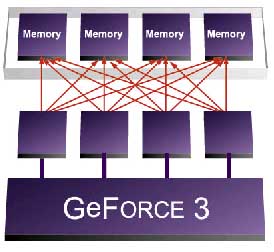NVIDIA GeForce3 Investigation: What NVIDIA didn't tell us
by Kert Chian on May 15, 2001 1:18 AM EST- Posted in
- GPUs
Crossbar memory controller

The crossbar memory controller, of which there are four,
is capable of 64-bits of individual access. These controllers communicate
with each other, the framebuffer and the rest of the graphics subsystem.
If there are only 64-bits of framebuffer access (equivalent to a scanline
with two 32-bit pixels or four 16-bit pixels), it is entirely plausible
that the other three controllers may be load balanced to service early Z-checks
or texture queues.
The 'Serious Sam Test 2' benchmark shows the synergistic effects of the
aforementioned bandwidth optimizations. There are on average 12,500 triangles
per frame. Objects that require three texture layers are rendered in at
least two passes. In a sense, this puts the GeForce3 at a disadvantage as
two passes can be collapsed into a single pass on its quad-texturing hardware
and thereby save a framebuffer readback.
With reference to figure 1, recall that 16-bit theoretical fillrates of
GeForce2 and GeForce3 are comparable. However, figure 2 (below) shows GeForce3
with a significant lead over GeForce2 in 16-bit rendering. Z-compression
is a definite factor here. Again with reference to figure 2, note that GeForce3
at 32-bit color only comes close to, but does not exceed, GeForce2 at 16-bit
rendering. This is in spite of GeForce3 using only a 16-bit Z-buffer as
well as Z-buffer optimizations. It would appear that GeForce3 is unable
to compensate for the 32-bit color buffer readbacks that are a consequence
of multi-pass rendering.

Figure 2: Serious Sam Test 2
| Resolution | 640x480 | 800x600 | 1024x768 | 1280x1024 | 1600x1200 |
| GeForce3, 16-bit |
65.1 |
62 |
56.6 |
50.4 |
43.5 |
| GeForce3, 32-bit |
65.4 |
61.4 |
56.0 |
47.8 |
39.2 |
| GeForce2, 32-bit |
64.4 |
58.7 |
51.3 |
38.9 |
29.0 |
| GeForce2, 16-bit |
66.2 |
62.3 |
56.7 |
48.6 |
40.0 |










0 Comments
View All Comments